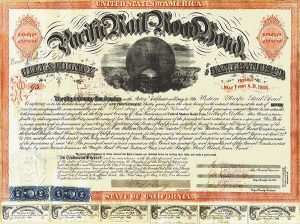A bond is a long-term liability with a specified amount of interest and specified maturity date. They have general features in common. They vary by issuer type and form of collateral. They are bought and sold like stocks and have valuation techniques involving risk measures.
General Features of Bonds
Bonds represent the indebtedness of their issuers for a specified sum called principal. They have have maturity dates ranging from one day to thirty years. Owners receive a flow of payments or interest in return for use of their money. Generally, the longer the maturity, the higher the interest paid.
The going interest rate in the bond market is determined by the collective evaluation of the issuer’s credit risk, inflation expectations and the risk-free rate. Although all interest rates fluctuate, short-term rates are more volatile than long-term rates.
The indenture is the document which specifies the terms of the bond issue. To protect your interests, a trustee is appointed for each bond issue make sure the issuer does what they are supposed to do. Most bonds are issued in a nameless book form held by your custodian and cleared through a clearinghouse in New Jersey called the DTC (Depository Trust Company).
Risk
All bonds have risk with varying degrees:
- Default risk- interest and principal will not be repaid
- Interest rate risk- price declines, principal moves inversely to changes in the market rate
- Inflation risk- changes in actual inflation affects purchasing power
- Call risk- issuer may redeem bonds earlier than anticipated maturity
- Reinvestment risk- investing proceeds at a lower interest rate
Even though it’s assumed the federal government will make good on their obligations, the price of Treasuries fluctuate prior to maturity. This is due to changes in the market rate and expected inflation rates.
To aid buyers of debt, several companies have developed a credit rating system which evaluate the degree of risk for a significant number of issued bonds. The highest rated ones have the least amount of risk and the best chance of not defaulting while the riskiest issues are called junk bond or high yield securities and usually pay higher interest.
Mechanics of Buying Bonds
The bond market market is about a third larger than the stock market. Bonds are purchased like stocks, either from a broker/dealer or an exchange. After the bond is purchased, a confirmation is sent by your custodian.
Bonds earn interest everyday, but the firm distributes the payments only twice a year. When a bond is purchased, the buyer owes the previous owner accrued interest for the days the owner held the bond. When the bond is sold, the seller receives the accrued interest.
A few bonds trade without accrued interest, usually in default. These bonds are rated below investment grade and are only suitable for speculators. The risk of buying them is substantial but if they resume paying interest, the return can be substantial.
Bond Types
Governments at all levels issue bonds to cover the shortfall from tax receipts and expenditures in times of budget deficits. Issuers include federal governments, federal agencies, state and local governments and other political subdivisions such as school and water districts.
Corporations issue many types of bonds either secured or unsecured:
- Mortgage bonds- secured by specific assets
- Equipment Trust Certificates- issued by railroads and airlines secured by planes and rolling stock
- Debentures- unsecured promissory notes supported by the firm’s general creditworthiness
- Income bonds- riskiest because the firm only pays interest if it earns it
- Convertible bonds- pays interest but has added feature allowing holders to convert to common stock
Legally, preferred stock is considered an equity, but due to its fixed payout nature, it has the characteristics of a bond. They are primarily issued by utilities and financial institutions and usually unsecured. Because of their lowly statue, they generally pay a higher yield than bonds.
Valuation
The price of any bond is primarily related to the interest paid by the bond, the interest rate investors may receive on comparable, competitive bonds and the maturity date.
The current price of a bond equals the present value of the interest payments plus the present value of the principal received at maturity. The discount rate used in the calculation is the current interest being paid by newly issued competitive bonds with the same length of maturity.
The definition of yield associated with bonds has three very important different meanings:
- Current yield- annual interest payment divided by the current price of the bond
- Yield to Maturity- considers current income when determining annual return if bond is held to maturity
- Yield to Call- similar to yield to maturity except assumption is bond will be called at call date
Duration
The price volatility of bonds with equal coupons and different terms may be compared on the basis of time. For a given risk class, the price of the bond with the longer term to maturity should be more volatile.
 Computing yield to maturity may be used to comparing bonds with common features, but doesn’t work with bonds with different maturities and coupons. An alternate technique, duration, compares bonds with varying maturities and coupons by determining each bonds sensitivity to interest rate changes.
Computing yield to maturity may be used to comparing bonds with common features, but doesn’t work with bonds with different maturities and coupons. An alternate technique, duration, compares bonds with varying maturities and coupons by determining each bonds sensitivity to interest rate changes.
Duration is defined as the time it takes for the bondholder to receive interest and principal back. It is a weighted average encompassing the total amount of the bond’s payments and their timing.
Bond Portfolio Management
Since bonds pay a fixed income and mature at a specified date, they are conducive to passive management. Interest is collected and principal paid back at a known amount. The market value of the portfolio fluctuates but the investor is assured of a specified return of principal if held to maturity.
The construction of a passively management portfolio takes into consideration reinvestment risk and matches the portfolio’s cash flow needs to your needs. Techniques involve staggering maturity dates and interest payment cycles.
A more active management uses the duration to manage the reinvestment risk and requires frequent trading of bonds. A strategy designed to take advantage of an expected change in rates paid by one type of bond relative to a different type requires bond swapping.
Visit these topics for further detail or return to the Investment Basics page:
- Basics Introduction
- Security Markets
- Information Sources
- Risk and Portfolio Theory
- Investment Companies
- Stock Valuation
- Macroeconomic Environment
- Statement Analysis
- Bond Market
- Foreign Securities
The material presented on this page and Investment Basics pages were adapted from Dave’s lecture notes for the Investments for Professionals course taught at UCLA 1998-2005 and three decades of practical experience. See our Site Credits page for reference sources.


